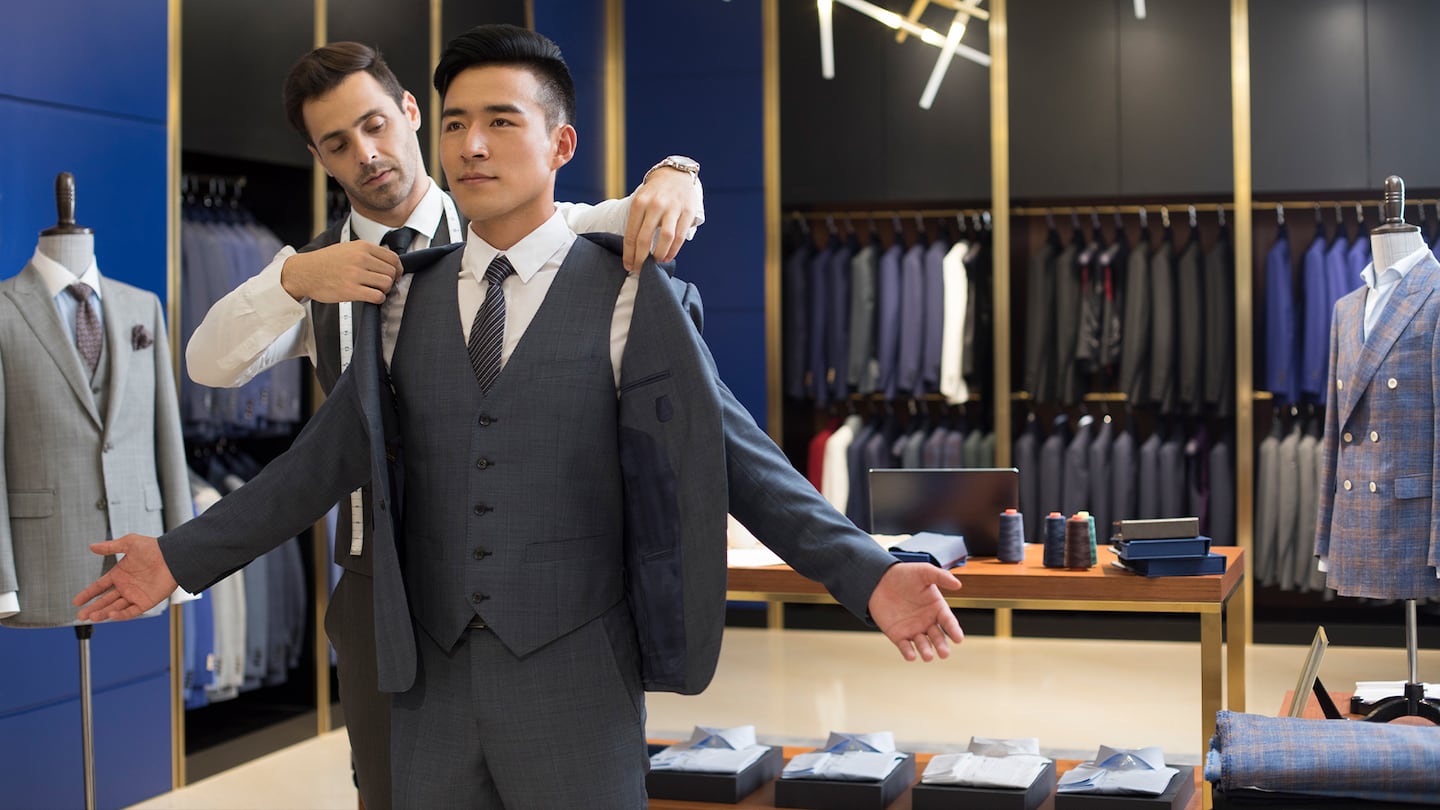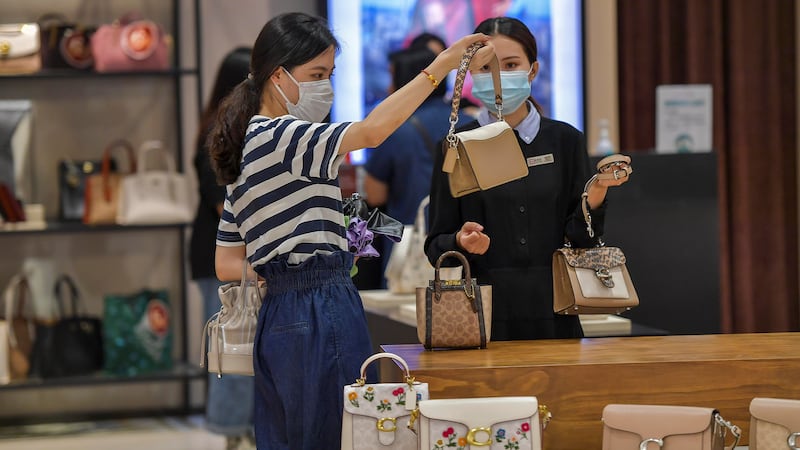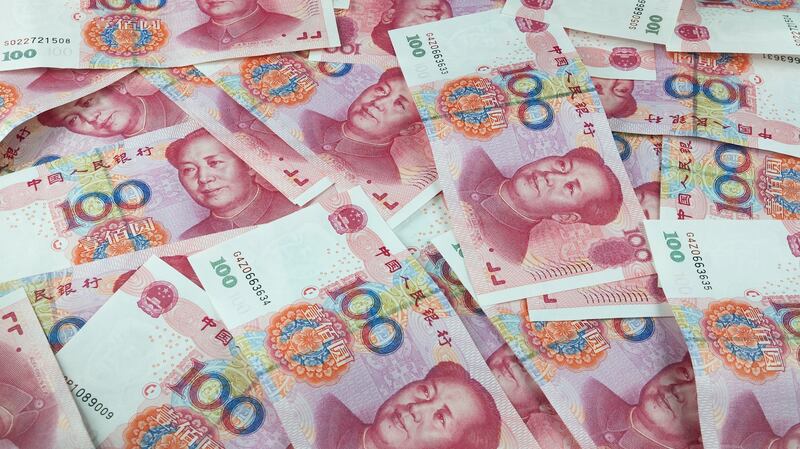
The Business of Fashion
Agenda-setting intelligence, analysis and advice for the global fashion community.

Agenda-setting intelligence, analysis and advice for the global fashion community.

The global luxury industry may be enjoying a rebound from the pandemic but growing uncertainty about the health of one of its most important markets means brands and investors aren’t celebrating just yet.
On top of concerns about a looming global economic downturn, the luxury goods sector is increasingly anxious about the outlook for the crucial China market. Before the onset of Covid-19, the Chinese were luxury’s largest consumer group by nationality, driving 33 percent of sales in 2019 — a share that is expected to grow to 40 to 45 percent by 2025, according to consulting firm Bain & Co.
Most of that spending used to happen abroad but travel disruptions associated with the pandemic caused much of it to shift to China. The mainland’s share of the global market grew from about 20 percent in 2020 to around 21 percent in 2021. Bain predicts this growth to continue, putting the country on track to become the world’s largest luxury goods market by geography by 2025, regardless of future international travel patterns.
After a bumpy ride in the first year of the pandemic, the China market became the saviour of the luxury goods industry last year, almost doubling in size compared with 2019 levels to €60 billion ($60.2 billion), Bain estimates. But now, with a highly transmissible subvariant of the virus putting President Xi Jinping’s zero-Covid policy to the test, brands are feeling the impact on their top lines.
ADVERTISEMENT
Companies from Kering to Tapestry to Burberry reported that the strong sales momentum China saw at the start of the year ground to a temporary halt as strict lockdowns hit key cities, causing store closures and logistical disruptions. How long sales in the market will remain dampened after this latest wave of infections and restrictions is unclear.
Experts believe that the government’s zero-Covid policy is unlikely to change before the Communist Party National Congress in November, where Xi is expected to secure an unprecedented third five-year term in office. But that policy is just one of many factors to consider.
While most brands seemed confident that the market would pick up again once lockdowns lifted, a rebound to 2021 spending levels is also dependent on the severity of future Covid infections, the strength of local and global macroeconomic headwinds and the extent to which consumer confidence is impacted by these factors.
To be clear, the long-term fundamentals of the all-important China market remain strong, but how the next six to 12 months will play out remains more of a debate among luxury industry analysts.
Though the situation remains fluid and new infections have been increasing in recent days, most major cities that were severely impacted by lockdowns in the spring have been gradually returning to daily life, said Iris Chan, partner at consulting firm Digital Luxury Group.
“From that perspective, you should see a bit of ‘revenge spending’ happening,” she said. “The only caveat to that is if there’s a [Covid] case that pops up, that area is shut down pretty quickly.”
As seen over April and May, lockdowns in key cities like Shanghai and Beijing have a disproportionate impact on brand sales due to their status as luxury shopping hubs. Beijing accounts for about 15 to 20 percent of luxury sales in mainland China, while Shanghai drives about one third and houses about 20 percent of luxury stores, according to HSBC research.
At Burberry, for example, 40 percent of distribution in the region was hit by store closures or restricted hours in May. HSBC expects most brands will see revenue from China down 25 percent in the second quarter, with retail sales down 50 percent in May and 40 percent in April.
ADVERTISEMENT
“What has been probably underestimated is the fact that it’s a disruption which is more severe than the one we observed during the summer [last year],” Kering chief financial officer Jean-Marc Duplaix said on a call with investors in April. “During the summer, you had some restrictions in terms of traffic, some moderation in terms of traffic. Here, we are coping with real lockdowns with some heavy consequences for our Chinese clients and our Chinese employees. So it’s fundamentally different.”
Not only do restrictions like these create volatility in demand, they also impact logistics. Lockdowns in Shanghai injected fresh chaos into already disrupted supply chains as most luxury brand warehouses are located in or near the city. This had a ripple effect as far afield as Chengdu, according to Bernstein analysts, and caused delays in the shipment of online orders. Indeed, some brands are still trying to fulfil orders made up to four months ago that were backed up due to the congestion.
Should there be no further lockdowns in key cities — though this assumption is looking increasingly unlikely — it is probable sales of luxury goods will bounce back sooner rather than later.
Once restrictions in Shanghai were lifted at the start of June, there was a “tremendous pickup,” said HSBC global head of consumer and retail research Erwan Rambourg, pointing to queues outside several luxury malls, including Shanghai’s Plaza 66. Even if consumers are cautious about returning to stores for fear of catching Covid or being forced to quarantine outside their homes, online sales and remote selling should see a boost as logistical backlogs ease up.
That said, continued restrictions across the country will mean domestic travel will likely remain dampened. “The impact of that is mostly on luxury brands that don’t really have a presence in those lower than first-tier cities,” said Chan.
Provided that the most important shopping hub cities avoid further lockdowns, sales momentum is expected to build in the third quarter, returning to last year’s levels by the end of the year and going into the start of 2023, according to Bain.
However, some analysts warn that 2021 may not be the best benchmark for what normal is in China since the onset of the pandemic. “We do not think industry growth will revert to the levels seen in the last two years, which have been exceptional,” said Deutsche Bank equity research analyst Adam Cochrane.
Richemont chief executive Johann Rupert was similarly cautious about assuming the reopening of the Chinese economy would lead to an instant boom in demand for luxury like the country experienced last year.
ADVERTISEMENT
“We must expect that China’s re-emergence after lockdown will not be as dramatic,” he said on a June call with investors. “It’s not doom and gloom, it’s just saying for triple-digit growth, don’t think it’s going to be like we have in the United States at the moment. They’re in a different period of the cycle really,” he added.
Even with the recent easing of restrictions, the severity and unpredictability of zero-Covid measures imposed during this latest wave is likely to have a hangover effect on how ready some shoppers are to splurge again on luxury.
“The bullish view is that consumers have saved a lot during the lockdown period and are now eager to spend,” said HSBC’s Rambourg. “The bearish view would be that psychology is greatly affected.”
For many living in China, the latest round of restrictions has been significantly more severe than those in 2020: food shortages, supply chain disruptions, and concerns about the health of China’s economy left many feeling dispirited and anxious. Younger, urban, middle class consumers — a demographic driving significant industry growth in mainland China — have been particularly fearful for their financial stability.
“Savings and deposits are definitely at a high, and loans are at a low, so you’re definitely seeing consumers conserve their funds and think a little bit more about those larger spending,” said Chan. “They’re not spending as loudly as they might have in the past.”
Yet some industry leaders remain optimistic that demand from consumers will stay buoyant. Analysts at Bain say there are signs Chinese consumers are returning to shop in anticipation of a fast recovery as soon as restrictions are fully lifted, and social life has resumed.
“We’ve seen China being very resilient through Covid. Our consumer scores there are some of the highest we have around the world,” said Ralph Lauren chief financial and operating officer Jane Nielsen on a call with investors in May.
Others are more cautious, citing the deteriorating picture in the Chinese economy, including a looming real-estate debt crisis and stagflation. A government crackdown on the tech industry and other sectors has left many companies exposed to an uncertain operating environment, pushing them to turn to mass layoffs — affecting mostly middle-class Chinese.
With China’s consumer confidence index in April at its weakest level since records began, Chinese premier Li Keqiang saying the economy could struggle to record positive growth in the current quarter and youth unemployment rising, the luxury consumer cohort that will be disproportionately affected is middle-income earners.
“For the high-net-worth [individuals], not much has changed … It’s that middle class that has really been affected, not just because of Covid, but because of regulations and policies,” said Chan. “That is going to be a challenge in the sense that they were the biggest consumer group driving a lot of the growth in luxury in the last several years.”
There is also the government’s “common prosperity” policy to consider, an announcement last year which ostensibly aims to restrain “unreasonable incomes” and expand the country’s middle class. So far, no legislation has been announced, and no concrete steps have been outlined, but political experts cite the possibility of tax rises for China’s higher earners. Until the policy becomes clearer, this only adds to the climate of uncertainty in the local luxury market.
Tensions have been rising between China, Taiwan and Taiwan’s allies, like the US, over China’s claim of sovereignty over the island. Though the comparison is problematic in many ways, some have drawn parallels between current China-Taiwan relations, and Russia-Ukraine relations before war broke out between the latter two countries.
Should China choose to follow in Russia’s footsteps by taking military action in Taiwan, the consequences could be disastrous for the global economy and therefore the luxury sector. To be sure, experts currently predict this scenario to be unlikely, but given how quickly tensions between Russia and Ukraine escalated earlier this year, the possibility can’t be ruled out entirely.
“We see now with the Russian-Ukrainian war how fast markets can get out of the balance,” said Daniel Langer, chief executive at luxury strategy firm Equité and executive professor of luxury strategy at Pepperdine University in the US. “In China, we’re not yet at that point, but you can see tensions [between China and Taiwan, and between Beijing and Hong Kong],” he continued. “There is a possibility that at some point, maybe for geopolitical reasons, brands will be much more restricted to operate in China.”
Bernstein analysts view a Chinese invasion of Taiwan as improbable, but “recognise a very significant downside if it materialises,” Luca Solca wrote in a recent note, estimating it would see sales at luxury companies plummet around 40 percent.
“A world with sanctions hitting China the same way as Russia today would experience one of the sharpest recessions in history, similar to a [world war] experience,” Solca wrote.
Barring the realisation of the worst-case scenario for a mid-term geopolitical crisis, China will remain an incredibly important market for luxury goods consumption in the long term despite the many short-term headwinds in both the local and global economy.
“The consumer sentiment towards luxury brands hasn’t changed,” said Bain partner Federica Levato. “They always see this market very positively, and they strongly want to go back to buying [luxury] products.”
If anything, there is a danger that the industry has already become over-reliant on China as a growth driver. As luxury brands double down on China while preparing for economic headwinds, they should also work to unlock high-potential growth markets elsewhere as a more geographically diversified business is important to spread risk.
Nevertheless, just as China has fuelled much of the growth for the luxury industry over the past decade, the market continues to represent significant untapped opportunity in the decade ahead. Louis Vuitton, the largest brand by sales globally, is estimated to be targeting less than 2 percent of the Chinese population, and likely only counts one tenth of that small portion as current customers, according to HSBC research.
“I don’t see any reason why the luxury market should not be very dynamic in China and [continue to grow],” said Equité's Langer, adding, “China’s going to remain a critical market for luxury brands — it’s just too sizeable.”
THE LATEST NEWS FROM CHINA
by Zoe Suen
时尚与美容
FASHION & BEAUTY

Zero-Covid Policies Weigh on Richemont and Burberry Sales
The government’s strict zero-Covid strategies in the crucial luxury market continue to negatively impact top-line performance for some luxury players. China’s lockdowns, store closures, mass testing and tourism slowdown have hit the likes of Richemont and Burberry, and investors are increasingly worried. Richemont saw sales in the mainland drop 37 percent in the quarter ending June, while Burberry’s like-for-like sales were down 35 percent, with 40 percent of the latter’s distribution effectively closed earlier in the quarter, according to chief operating and financial officer Julie Brown. Both companies said that the situation in China is on the mend, but the rise of infections is threatening further blows. (Bloomberg)
Lanvin Owner Plans Its Next Acquisition
Lanvin Group is aiming to add another brand to its arsenal by next year, chairman and CEO Joann Cheng said in an interview. The acquisition, for which executives are screening targets now, would follow Lanvin’s IPO on the New York Stock Exchange in October or November, which will help it ramp up sales in key markets like the US and China and better target younger shoppers. The latest brand to join the group’s roster was Sergio Rossi. Earlier this month, the group reported that its 2021 revenue was up 39 percent year-on-year, while Lanvin was “well on track” for its earnings before interest and taxes (EBIT) to reach profitability by 2024. (Bloomberg)
Manolo Blahnik Wins Long-Running Trademark Dispute in China
The conclusion of the 22-year legal battle opens the way for the British brand to trade across the country for the first time since 1999. The first-to-file system of China’s trademark regime has left room for trademark “pirates” who register and obtain rights to brands and then seek to sell the registrations on to the bona fide owners when they expand to China. Manolo Blahnik had previously struggled to claim its name in China because of a trademark filing by a local individual. Now, the Supreme People’s Court of China ordered the invalidation of that trademark registration. The case may set a precedent for other fashion brands looking to enforce their rights in China. (BoF)
Obstacles Ahead as Shein Eyes US IPO
Factors accounting for the Chinese ultra-fast fashion giant’s meteoric rise could now be standing in its way. On July 14, media reports claimed that Shein was readying for a US IPO as soon as 2024. An IPO helps to explain recent efforts to improve Shein’s environmental, social and governance (ESG) performance, which could stand in the way of a successful debut. The company has drawn criticism and scrutiny for alleged intellectual property violations, a lack of transparency around its supply chain and its contribution to excessive consumption and clothing waste. (Sina Finance)
Hermès’ New Wuhan Outpost Attracts Crowds on Opening Day
Last week, the luxury brand unveiled a new two-story boutique in Wuhan’s Heartland 66 mall, which the brand says highlights its dedication to Hubei Province’s bustling capital. On its first day, the store raked in 30 million yuan (around $4.4 million) and drew a long queue of big spenders, despite the only inviting “50 top-tier customers” to the opening, WWD reported, citing a user on Xiaohongshu. The new store, which was designed by architecture firm RDAI, houses rooms made for the brand’s VIP shoppers. On Xiaohongshu, buyers shared photos of their hauls, ranging from the house’s Lindy style to an Ostrich Kelly bag. The brand hasn’t confirmed the sales figure. (Inside Retail)
科技与供应链
TECH & SUPPLY CHAIN

ByteDance Plots Launch of Chinese Instagram-like App
The group behind TikTok and Douyin is preparing to introduce a social media app for younger users, according to a corporate registration. Named Kesong, the platform will house user-generated images and posts on topics including fashion, collectibles and hobbies. A release date hasn’t been announced, but the app’s page says it will go live this summer. Though Bytedance’s Douyin was a clear success, more recent attempts to tap younger audiences through Xincao (2018) and Xintu (2019) fell short. Moreover, Kesong faces tough competition and will need to nab screen time from the likes of Xiaohongshu and Bilibili. The latter, in particular, is one of the country’s top platforms for Gen-Z, and like Kesong is a space for users to engage with content about both mainstream and niche interests. (South China Morning Post)
Alibaba Earnings Turnaround Hopes Revived After Shares Rise 60%
Top brokerages are posting buy calls after the retail giant surged from its mid-March record low. The news comes amid speculation that Beijing’s tech crackdown may be drawing to a close. It also comes after Alibaba mapped out its strategy to analysts and its merchants last month, which it hopes will address obstacles experienced by businesses as well as demands from people living in lockdown-hit cities. While the group’s most recent quarterly revenue beat estimates, investors are wary of expecting a broader economic recovery from China, where Beijing’s strict zero-Covid stance shows no signs of wavering. (Bloomberg)
One Company’s Quest to Remove China From Its Supply Chain
Jean Madar, founder and chairman of New York-based fragrance seller Inter Parfums, is among the executives choosing to shift operations out of the Chinese mainland. Madar cites supply chain issues relating to Beijing’s lockdowns, which caused millions of dollars’ worth of perfume and cologne to sit in an unreachable Shanghai warehouse. The likes of Inter Parfums are rethinking low-cost importing: almost 20 percent of supply chain executives told McKinsey they had shifted some production back to a nearby country in the past year, doubling 2021′s figure. When it comes to fashion, the main benefactors are Southeast Asian nations like Cambodia, which made up the largest year-on-year increase in US apparel imports for the month of May. (The Wall Street Journal)
消费与零售
CONSUMER & RETAIL

China’s Retail Sales Up 3.1% in June
The country’s retail sales of consumer goods were up by over 3 percent year-on-year, and 0.53 percent from May to reach 3.87 trillion yuan (around $572.7 billion) according to the National Bureau of Statistics. The increase reverses the decline in sales posted in April and May while cities like Shanghai were in the throes of strict lockdowns. Moreover, online sales of physical goods were up 5.6 percent year-on-year, and now make up almost 26 percent of overall retail sales in the mainland. Though the figures are a sign of a slow recovery, Beijing’s tough zero-Covid policies are expected to continue until at least November. (Reuters)
With Higher Demand, Chinese Consumer Prices Set to Rise
Growing demand for consumer goods following several strict lockdowns is predicted to increase inflation rates in the mainland, say analysts. China’s consumer price index (CPI) was up 2.5 percent year-on-year in June, outpacing May’s 2.1 percent rise, according to the National Bureau of Statistics. The figure exceeds the expected 2.4 percent increase and comes as inflation is expected to persist across the globe. Though Beijing set a consumer inflation target of around 3 percent for 2022, economists forecast CPI inflation will surpass 3 percent in Q2. Meanwhile, the producer price index (PPI), which marks the prices paid to factories by wholesalers, was also higher than expected, up 6.1 percent in June from a year earlier. (South China Morning Post)
How Chinese Are Spending: Caution, Price Sensitivity and Local Brands
In a newly released report by Kantar, the media company outlines how shoppers in the mainland shopped over the last year. According to Jason Yu, managing director of Kantar Worldpanel’s Greater China division, heavy promotions are driving sales post-2021, while spending in the personal care and household categories is still on the rise. As in previous years, home-grown brands valuing higher volumes are taking market share from global players focusing on premium sales. Unsurprisingly, e-commerce maintained solid growth throughout last year, but its 15 percent growth figure only comes up to half the rate of previous years. Ultimately, the increasing fragmentation of online channels means brands need to rethink their strategies to reach the right consumers. (Kantar)
政治,经济与社会
POLITICS, ECONOMY, SOCIETY

Chinese Economy Narrowly Avoids Q2 Contraction
The country’s GDP grew 0.3 percent year-on-year in the quarter ending June — missing economists’ estimates of 1.2 percent, and reflecting a decline from Q1. It is China’s second-worst quarterly GDP figure in three decades. The mainland is forecast to miss its target of around 5.5 percent annual growth for the year, which would mark another three-decade low. The data further signals that both local and global headwinds are stifling China’s economic growth. Thirty-one Chinese cities (accounting for around 17.5 percent of national economic activity) are still experiencing full or partial lockdowns, according to investment bank Nomura. Furthermore, youth unemployment is on the rise, growing to a record 19.3 percent during the period. (Financial Times)
Xi Visits ‘Core Hub’ Xinjiang for First Time in Eight Years
President Xi Jinping made a rare visit to the region ahead of China’s 20th Party Congress. It marks Xi’s first trip to Xinjiang since it became a geopolitical flashpoint due to reports of forced labour and detention of Uighurs and other ethnic minorities by local authorities. Xi visited the region on July 12 and 13, following his visit to Hong Kong to celebrate 25 years of Chinese rule. (South China Morning Post)
China Decoded wants to hear from you. Send tips, suggestions, complaints and compliments to robb.young@businessoffashion.com.
With consumers tightening their belts in China, the battle between global fast fashion brands and local high street giants has intensified.
Investors are bracing for a steep slowdown in luxury sales when luxury companies report their first quarter results, reflecting lacklustre Chinese demand.
The French beauty giant’s two latest deals are part of a wider M&A push by global players to capture a larger slice of the China market, targeting buzzy high-end brands that offer products with distinctive Chinese elements.
Post-Covid spend by US tourists in Europe has surged past 2019 levels. Chinese travellers, by contrast, have largely favoured domestic and regional destinations like Hong Kong, Singapore and Japan.